What Can I Feed My Cat if I Run Out of Food
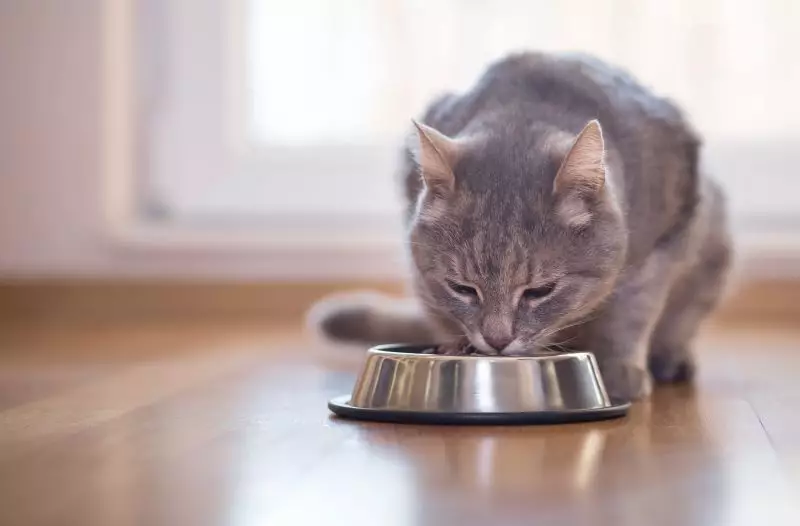
Without a doubt, we are living through strange and stressful times. While our pets can provide a great source of comfort and stress relief, they can also cause us additional worry, particularly when it comes to their care and well-being under the challenging circumstances we are facing.
Pet food may be high on the list of potential causes of concern for many cat owners, particularly if there are shortages in your neighbourhood or city. In recent times, pet food has been subject to panic buying and stockpiling – and if you are lucky enough to find your cat's usual brand of food in stock, there may be quantity limits on how much you can actually purchase. Or you may be unable or unwilling to venture out to the shops to get it.
 If your cat is on a special diet or is particularly fussy, and her preferred brand is currently unavailable, you may be wondering what cat food alternatives you can try.
If your cat is on a special diet or is particularly fussy, and her preferred brand is currently unavailable, you may be wondering what cat food alternatives you can try.
These unusual conditions are leaving many cat owners questioning what human foods can cats eat, and what they could use for emergency cat food. So, what exactly are your options if you are running low of Felix's or Fifi's favourite food and you don't want to dip into your emergency supplies?
Ordering from an online supplier
Ordering cat food online is becoming an increasingly popular option; however, there is no guarantee that Fifi's favourite brand will be in stock or, if you have left it a bit late, that your order will arrive before you run out. It appears that pet food companies are seeing sudden and significant growth in their sales at this time as people all over the world are turning to the internet to stock up on food and other products for their pets. Some pet food websites now state that due to high demand, current delivery times are running considerably longer than usual on food and supplies.
Switching brands of cat food
The basis of your cat's diet should be a high quality, balanced, premium commercial cat food that is appropriate for their life stage and health status. International Cat Care generally recommends feeding healthy cats a variety of both wet and dry food so that cats can enjoy the benefits of both food types – wet food helps to ensure adequate water intake and dry food is good for oral health – and so they do not become accustomed to only one type of food. Additionally, feeding a mixed diet may reduce the risk of developing obesity, compared to feeding a dry only diet, according to research.
If you need to switch brands, the most important advice we can give is to plan ahead and not wait until you're already out of your cat's regular food. Make the switch gradually, substituting a small portion of the new food for the old food each day. If you are looking at the range of cat food alternatives available, one of the most important things to look out for when choosing a food to feed your cat is that it is a 'complete' food – this will be stated on the packaging – meaning that it has been developed to meet all of your cat's nutritional needs. If you are unsure if the options are suitable for your particular cat, buy only a small quantity as emergency cat food and be sure to check with your vet before stocking up with large quantities – and also with Fifi to make sure she is happy to eat it!
Puppy and dog food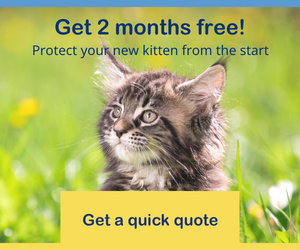 are not suitable as kitten food or cat food substitutes as they are deficient in taurine, an essential protein that cats require from their food. While dog food won't make your cat sick, it is not designed for the strict nutritional needs of cats, so is definitely not a suitable cat food alternative.
are not suitable as kitten food or cat food substitutes as they are deficient in taurine, an essential protein that cats require from their food. While dog food won't make your cat sick, it is not designed for the strict nutritional needs of cats, so is definitely not a suitable cat food alternative.
Substituting human foods – "Help! I'm out of cat food what can I use?"
If you are completely out of cat food, or Felix is turning up his nose at the new and unfamiliar brand you just bought, don't panic! There are probably several nutritious options in your fridge, freezer or pantry that you can safely give to him as emergency cat food. Just be sure to check our guidelines below first, so as to know what human foods can cats eat, as there are also some foods there that could make him seriously ill.
And always ask yourself the following 3 questions before raiding the fridge for Felix or Fifi:
- Does this food contain a lot of salt and/or fat, which could cause excessive thirst and tummy troubles?
- Does my cat have any special dietary needs or allergies that this food may affect?
- Is this food on the list of dangerous foods for cats? If you are unsure, check the Pet Poison Helpline or other online resource first.
Good for humans, good for cats – what human food can cats eat
Domestic cats are true carnivores, meaning that they are primarily meat eaters and need animal protein to survive and thrive. This means that cats have some special dietary requirements that do not apply to many other animals, including humans and dogs, Basically, cats have a much higher protein requirement in their diet that is typically only be met by a meat-based diet, because they have come to rely on protein as an energy source.
In addition to requiring a much higher level of protein in their diet, cats also require specific amino acids to be present – these being taurine, arginine, methionine and cysteine. These amino acids are not found in plants, which means that finding suitable cat food alternatives (or kitten milk alternative) can be quite challenging, particularly for non-meat-eating households.
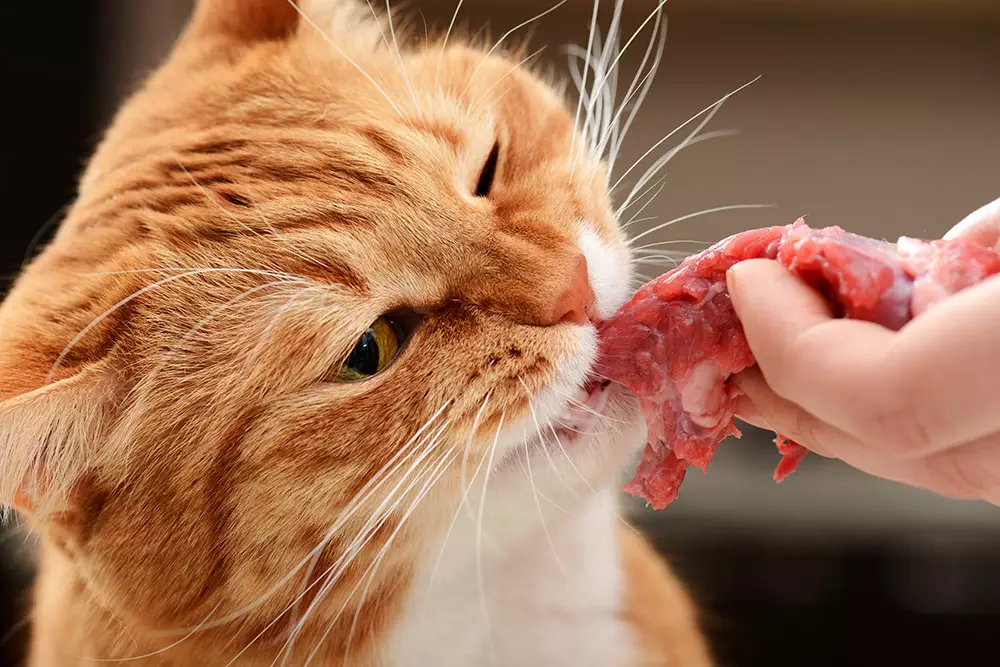
As obligate or true carnivores, cats also have a reduced ability to digest and utilise carbohydrates, because a carnivorous diet is typically low in carbohydrates. In contrast to many other animals, cats derive most of their blood sugar – and so their energy – from the breakdown of protein rather than carbohydrates. However, this does not mean that cats cannot use carbohydrates or that it should not be present at all in their diet, but as they have a more limited capacity to digest and utilise carbohydrates, cat food alternatives need to be chosen carefully.
Because of their unique and special dietary requirements, it is actually extremely difficult to provide a well-balanced diet for cats with home-prepared foods. But rest assured that while human food should only make up a small portion of your cat's diet, many human foods are perfectly safe to feed as emergency cat food. Unless you've been given any special dietary instructions to the contrary by your vet, what you should aim for is a serve of mostly lean protein, although there are a few suitable options or additions from other food groups as well. If you're a meat-eating home, then chances are you have some good choices on hand, whether fresh, frozen or tinned.
If Felix turns away from his bowl with a look of disdain, keep in mind that cats have an extremely well-developed sense of smell and the odour of food is particularly important to them. This is enhanced when food is slightly warmed, so cats prefer food that is around body temperature (around 35°C). Foods that have a high level of protein and fat, in general, are much more palatable for cats. While they can taste substances that are salty, sour or bitter, unlike humans and dogs they are not able to perceive sweet tastes. The texture of food is also important and in general cats prefer the texture of meat.
Emergency cat food options
Meat – Some great fresh meat options for cats include the following:
- Fresh, human-grade raw meat such as pieces of raw lamb or raw chicken with no preservatives added.
- Lean and plainly cooked portions of beef, chicken, turkey, lamb and pork.
- Lean, un-spiced deli meats in small quantities.
But be mindful of the following:
- Avoid processed meats and cooked manufactured meats, including bacon and sausages, as they can contain sulphite preservatives which can be detrimental to your cat's health.
- Avoid the fatty parts of the meat, the skin, and cooked bones.
- Avoid leftovers or recipes containing any items from the dangerous foods list (e.g. onions or garlic), any strange vegetables, heavy seasoning or wine.
- While small amounts of liver are fine, too much can lead to vitamin A toxicity.
Meat bones (raw only) – Bones can be "a bone of contention" when it comes to cat food alternatives. In the wild, cats would eat a whole animal carcass – meat, organs and bones. A diet of only the muscle meat of an animal is highly deficient in minerals such as calcium and will not allow the bones to grow properly.
Additionally, raw meaty bones can provide several important health benefits such as keeping teeth and gums healthy. On the negative side, too many raw bones may lead to constipation. Generally, 1 to 2 raw bones may be offered per week with a few days in between each serving. Always supervise cats when they eat raw bones.
- Suitable raw meaty bones include raw chicken (necks, wings, or drumsticks) and raw lamb shanks. The bone must be large enough so that the cat cannot fit the whole bone into their mouth or swallow the bone whole.
- Avoid large marrow bones (these have very thick outer rims), large knuckle bones or bones sawn lengthwise as cats may crack their teeth on these.
- Never give your cat cooked bones as these can be choking hazards. They can splinter, causing stomach lacerations and obstructions within the digestive system.
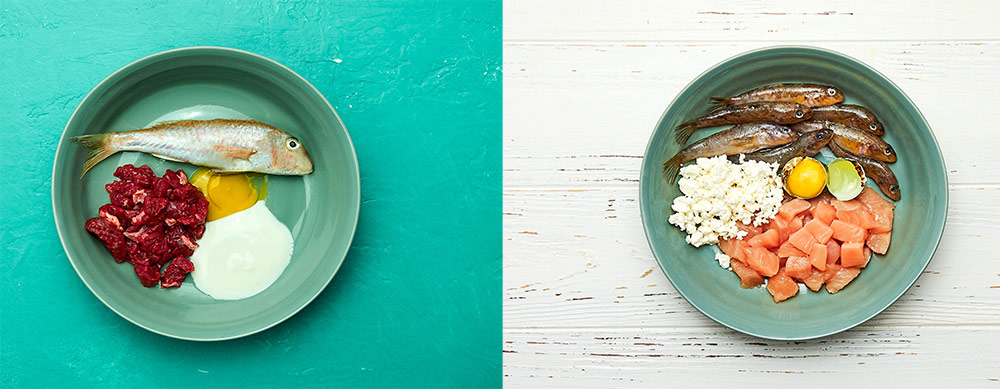
Fish – Contrary to common belief, tuna does not contain all the nutrients cats need. Cat food is truly the only source of nutrients that covers every base for your furry friend. If you feed your cat a diet consisting of only tuna, he or she will face severe health consequences sooner or later. However, in small portions, from time to time or as an emergency cat food option, tuna or other fish are fine:
- Cooked fish fillets are a good source of omega 3 fatty acids, which are good for your cat's heart, kidneys, joints and vision.
- Canned fish including salmon, tuna and sardines, packed in water and low in salt, rinsed and drained thoroughly, is another good option.
- Avoid feeding fish constantly as it is not a complete diet.
- Avoid sushi and raw fish.
Other proteins
Cheese – Small to moderate amounts of hard, mild cheeses like Colby, gouda, swiss or cheddar, cottage cheese.
Eggs – A great protein but be sure to serve only cooked eggs. Raw egg whites are bad for cats.
Yogurt – Natural, plain or Greek yogurt acts as a pro-biotic and provides a great source of protein. Provide in moderation. Avoid sweetened varieties, including those sweetened with 'natural' sugars.
Other food groups
It is important to remember that cats are 'obligate carnivores', which means they require meat in their diet, so their nutritional needs cannot be met by a vegetarian diet. However, in small quantities or combined with one of the protein options above, cat food substitutes can include:
Grains – A small serve of plain, cooked grains like mashed brown rice, barley, oats or breadcrumbs from whole wheat bread. Many cats enjoy cooked grains with a smaller texture, like couscous, polenta and millet.
Vegetables – Small amounts of finely cut, microwaved, steamed or boiled carrots, peas, green beans, broccoli, asparagus, pumpkin, squash and spinach are all okay to feed your cat on occasion. Fresh, frozen and canned varieties of these veggies are fine. Avoid corncobs, tomatoes and mushrooms. Avoid large chunks of vegetables.
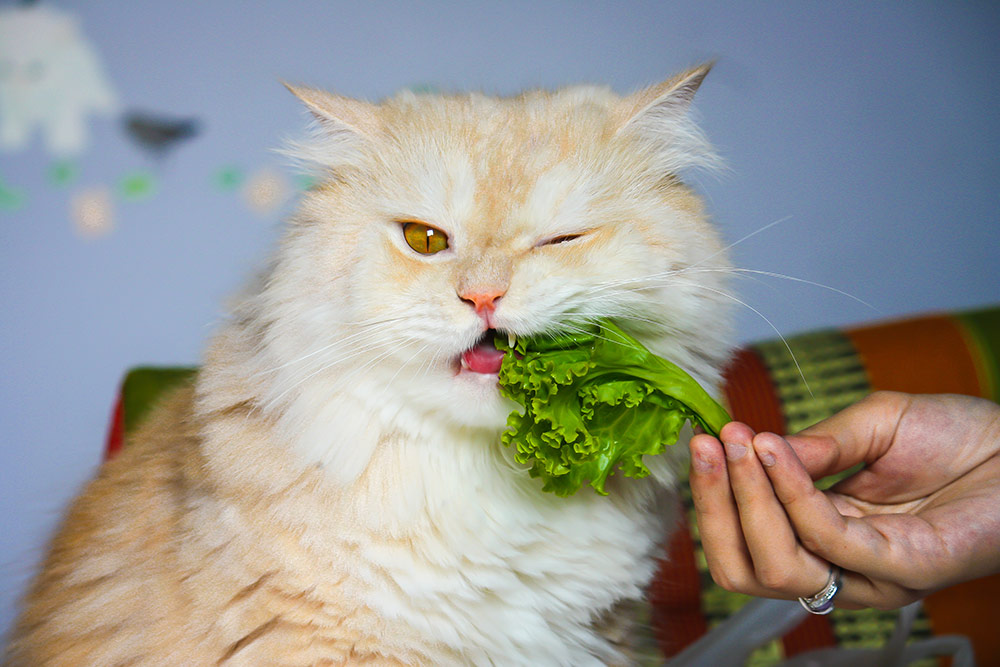
Fruit – Many cats don't like fruit – remember, they can't taste sweet flavours. If Fifi will eat them, bananas, blueberries, strawberries, cucumber, watermelon, cantaloupe and peeled apple slices (without the seeds) all make a healthy snack and a good source of vitamins. Cut up and remove all the seeds, stem and leaves.
Nuts – Cats have no trouble digesting peanuts and many enjoy the flavour. They can also have peanut butter in moderation. Nuts are high in fat and can cause tummy ache if too many are consumed.
A note about dairy products – Apart from kittens, most cats have low levels of the enzyme lactase – this is the enzyme needed to digest the major carbohydrate (lactose) present in milk. While not toxic to cats, dairy products can disrupt their digestive systems and even trigger food allergies. Many cats can tolerate a small amount of dairy that is low in lactose, such as hard yellow cheeses and plain yogurt, without any ill effects. However, consumption of ordinary milk, and especially in high quantities, can often lead to diarrhoea in cats, so it is best to avoid cow's milk, soft cheeses and other products high in lactose.
For kittens, a bowl of dairy milk is a perfectly safe option from time to time. If you are concerned about lactose, provide lactose-free milk. Other kitten milk alternatives include milk substitute products available from vets and pet supply stores.
Kittens are very adventurous and can end up hurting themselves whilst they are still growing. Their underdeveloped immune system means they can be vulnerable to getting infections and catching diseases.
It is important to take out pet insurance from the very start, to ensure that your kitten is always covered and before any pre-existing conditions are diagnosed. Get 2 months free pet insurance for your kitten2!
Human foods dangerous for cats – what you should never feed your cat
In general, you should avoid feeding your cat highly sweetened, salted, spicy or oily foods, as well as processed, packaged foods which are likely to contain artificial colourings, flavourings and preservatives. While many human foods are lacking in necessary nutrients – think 'treats' and fast foods – others can be downright dangerous, and some even deadly, to cats.
The foods listed below are all common human foods that are dangerous foods for cats and should never be fed to them, even in tiny amounts. However, this is by no means a comprehensive list, so if you are unsure about the safety of a particular food, please check the Pet Poison Helpline or other online resource before adding it to Fifi's bowl.
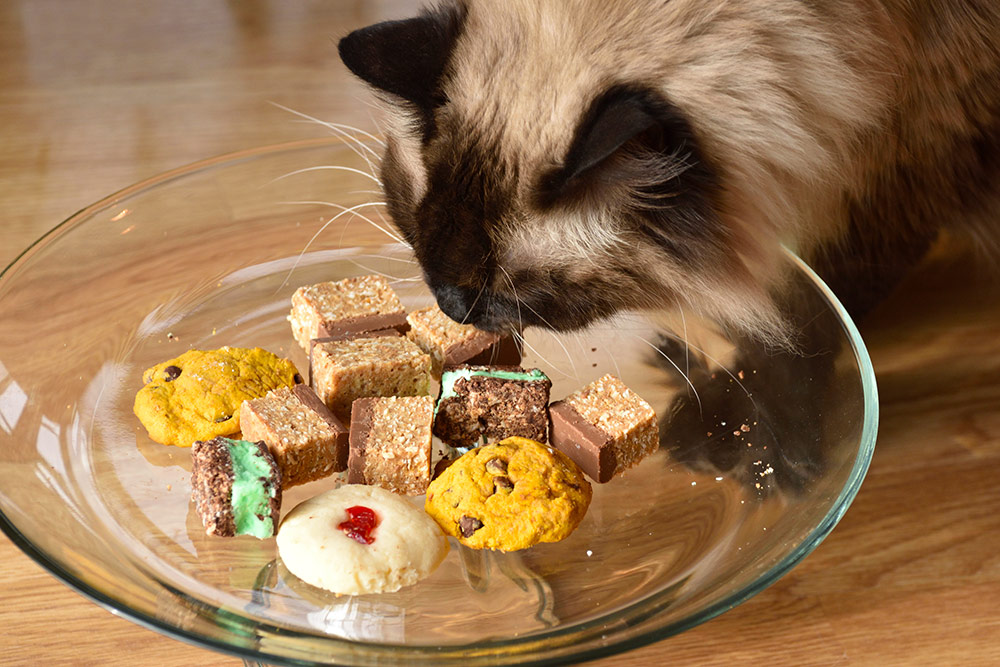
Alcohol – Wine, beer and other alcohol can be toxic, and even deadly, for to your cat. Logically, all foods or drinks containing even a small amount of alcohol are bad for cats. Alcohol is rapidly adsorbed into the cat's bloodstream and just a drop can cause dangerous declines in blood sugar, blood pressure and body temperature, with the effects being even worse in smaller breeds.
Avocados – Although super healthy for us humans, avocado contains persin, which is known to give cats an upset stomach. Ingestion of the pip can potentially cause an obstruction in the digestive tract, which can be fatal.
Bread dough and yeast – While cats can eat baked bread in moderation, raw dough made with yeast causes gastric dilation (expansion in the stomach) and the fermentation of the yeast creates ethanol (alcohol) which is absorbed into the blood stream.
Caffeine and coffee – A small amount of caffeine can affect the heart, stomach, intestines and nervous system, while a large dosage can be fatal. Caffeine is not just found in coffee and tea – other caffeine-containing foods include energy drinks, energy bars, chocolate, cocoa, colas and some medications, including diet pills, pain killers and cold medicines.
Chocolate and cocoa – Most pet owners are aware that chocolate is harmful to both dogs and cats. The reason is that chocolate contains theobromine, which is toxic for cats. Generally, the darker the chocolate, the greater its toxicity. Chocolate may also contain nuts, fats and caffeine, all of which are also on the list of what not to feed your cat.
Garlic, onions, chives and leeks – These flavoursome members of the Allium family and are highly toxic to cats. Ingestion of just a small amount can cause gastrointestinal irritation and oxidative damage to the red blood cells, which can lead to anaemia. Even in cooked, powdered or dehydrated form, they can be toxic, as they contain compounds that can break down your cat's red blood cells. This can lead to potentially life-threatening anaemia.
Grapes, raisins, currants and sultanas – These need to be kept away from your cat at all costs – including cakes, cereals and other foods containing them. They can cause acute kidney failure in most breeds, reducing the ability to produce urine and thereby filter toxins out of the body. Ingesting just a few can be extremely harmful, depending on the size of your cat.
Green or raw potatoes – While a plain baked or boiled potato is safe for your cat, do not allow him to eat any raw potatoes or any potato plants from your pantry or garden. This is because raw green potatoes contain a substance called solanine which can be toxic to some cats, resulting in "green potato poisoning".
Macadamia and other nuts – Nuts are high in fat content, which can cause stomach upsets and pancreatitis in your cat. Some nuts, including macadamias and mouldy walnuts, can be highly toxic and cause severe poisoning – just a handful of raw or roasted macadamias can make your cat really sick. Chocolate with nuts delivers a double blow and is high on the list of human foods to avoid.
Mushrooms – While there are several thousand species of mushrooms, only a small number are known to be toxic. These can cause severe problems to various organ systems, including the kidneys, liver and brain, and can even result in death. All mushroom ingestion should therefore be considered toxic to cats.
Rhubarb and rhubarb leaves – Rhubarb is a vegetable that is often used in pies, jams, sauces and juice. The leaves and stems contain soluble oxalates which can induce poisoning if ingested in large enough quantities, triggering abnormalities of the nervous system, kidneys and digestive tract. Rarely, acute renal failure can result.
Seeds from apples, peaches, plums, apricots and cherries – The seeds, as well as the stems and leaves, of these common fruits contain cyanide, which is poisonous if consumed, while the larger pips could cause intestinal obstruction.
Sugar, candy, lollies, ice-cream and gum
Tobacco – Exposure to nicotine in tobacco initially causes low heart and respiratory rates which then change to overstimulation. It can ultimately result in the animal's death.
Xylitol – Xylitol, the sweetener or sugar substitute found in many varieties of chewing gum, candy, baked goods, toothpaste and vitamins, is near the top of the list of foods to avoid. It can cause the rapid release of insulin in cats and result in hypoglycaemia. In some cases, xylitol poisoning can lead to liver failure within a few days of ingestion.
In summary
There's no need to stress if you run out of cat food for a short period, or don't want to dip into your emergency supplies. If you follow the above guidelines, you can safely feed your cat a variety of wholesome, nutritious, protein-based meals from the staples in your fridge, freezer or pantry.
Just be aware that when considering what human food can cats eat, it's best to err on the side of caution. Even if the food you serve Fifi isn't known to be harmful to cats, she could still have a small bout of upset stomach, diarrhoea or vomiting. If that happens, she may just be a little more sensitive to human foods than the average cat.
Also keep in mind that some cats are 'fussy eaters', which can develop when they are fed the same food over a long period. However, you may be able to tempt them to try something new by slightly warming their food, offering foods that are tasty (because they contain high levels of protein or fat) or have a strong odour, and by offering variety, including new and different foods from the safe suggestions above.
A pet insurance policy with Bow Wow Meow will help ensure you can always afford to give your pet the best treatment for dietary issues and management, along with many other health conditions.
-
Find out more about our pet insurance options for cats
-
Get an instant online pet insurance quote


Source: https://bowwowinsurance.com.au/pet-community/pet-talk/human-foods-for-cats/
0 Response to "What Can I Feed My Cat if I Run Out of Food"
Post a Comment